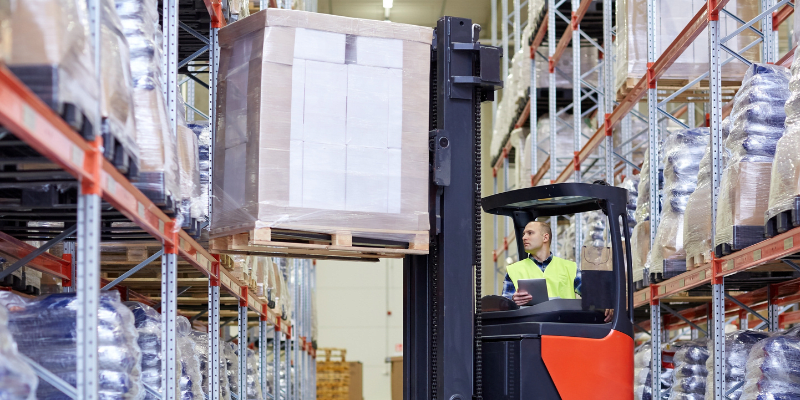Protect warehouse workers from struck by incidents: Real life examples and expert tips

Struck by incidents are a significant hazard in warehouse and distribution centers, contributing to traumatic, life-altering injuries and fatalities. WSPS Warehouse Specialist Norm Kramer, says there are two main causes of these incidents. “They occur when vehicles and mobile equipment strike pedestrians, and when material falling from racks and high storage strikes workers nearby.”
“With the high toll these incidents take on workers, and on workplaces (high direct and indirect costs), warehouse/distribution centers must take proactive measures to prevent them,” says Norm.
This means following a thorough hazard management process to ensure that struck by risks are identified and effectively controlled. Norm recommends Involving internal people in the process, including the warehouse manager, shipper/receiver(s), safety committee member(s), mobile equipment operator(s), truck driver(s), and pedestrian(s), to name a few.
“A tried-and-true approach to hazard management includes reviewing all related documentation, such as incident reports, policies and procedures and training; conducting observations and interviewing key staff; and reviewing applicable industry best practices, such as CSA standard B335, Safety Standard for Lift Trucks and A344, User Guide for Steel Storage Racks,” says Norm.
How can incident reports help?
“Reviewing incidents that have occurred in your workplace, and asking appropriate questions, can be an effective way to isolate and address root causes, and determine control measures,” explains Norm. Here are two examples:
Incident 1: A worker is struck by a falling load
A lift truck operator places a pallet on the upper level of a storage rack. Unbeknownst to the operator, the pallet pushes a dislodged box into the adjacent pallet, which falls to the floor and strikes a worker.
“Here are questions you can ask in reviewing this incident to help identify causes and solutions,” says Norm.
- Are loads secured with wrapping or strapping before they are placed on the rack?
- Are workers, such as order pickers working on one side of back-to-back racking when a load is placed from the other side?
- Do lift truck operators have good visibility by using different controls, such as the adoption of camera technology?
- Are lift truck operators competent? Have they received adequate practical training, such as placing pallet loads at higher elevations in a safe environment?
- Are racking accessories used, such as mesh decks, safety bars, back stop beam and netting, to keep loads from falling?
- Are pallets inspected to make sure they are able to support the weight of the load and don’t have any broken, cracked or missing parts that could make the load unstable?
- Are the pallets the right size for the rack? If the pallet load on the forks of lift truck makes unwanted contact with a pallet that is too large (excessive overhang on the beam) or too small (barely making contact with the beam), there is an increased likelihood the load will fall.
- Is there sufficient flue space between back-to-back racking to prevent pallet loads that are placed on the beam from pushing a pallet load behind it?
Incident 2: A worker is struck by a forklift truck
A lift truck operator reverses into another worker who is pulling a pallet jack over to the shrink wrapper, causing a critical injury.
Questions to ask:
- Do lift truck operators need to reverse?
- Can the pallet loads on the forklift be lower? This would give lift truck operators greater visibility and may prevent the need to reverse.
- Can risks to workers be minimized by adopting a one-way traffic flow?
- Can foot traffic be eliminated or reduced in areas where lift trucks operate?
- Is it possible to reorganize the equipment in the workplace, including pallet wrappers, garbage compactors, or pallet dispensers, to reduce traffic congestion of both people and mobile equipment?
- Is the right mobile equipment being used? Would a standup counterbalance forklift, which allows the operator to look in the direction of travel, be a better choice than a sit-down counterbalance forklift?
- Do lift trucks have safety features, such as back up warning sounds, a camera that allows the operator to see the path of travel, or swivel seats to make it more comfortable for the operator to turn and look in the direction of travel?
- Are operators instructed to quickly tap horn to warn pedestrians at blind corners, or when reversing or traveling through areas with obstructions? Equipment may not be seen or heard, until it is too late.
- Do mobile equipment operators travel at a safe speed, especially when working with people nearby, in tightly confined areas or at blind corners? If not, should the workplace adopt lift truck speed control technology that limits how fast an operator can travel? The Material Handling Equipment Distributor Association recommends in general a maximum speed of 13 km/hr (8 mph).
“Hazard management cannot be left to chance, including identifying struck by risk,” warns Norm. “Take the time to do it right, follow a stringent process, and get as much input as possible from the appropriate people. I’ve found from experience that lift truck operators who perform their duties day after day, perhaps for many years, have valuable insights to share to prevent struck by injuries.”
How WSPS can help
Connect with a WSPS consultant for help carrying out a job hazards analysis and risk assessments to prevent struck by injuries in your business. You can also book a free workplace walk-through with a safety expert to identify hazards and offer preliminary recommendations.
Resources
- Material handling resources for workers, supervisors and employers - Topics include: conveyor safety, racking, lockout/tagout, pedestrian safety, and safe lifting. Supervisor and employer resources are available in English. The worker resources are available in French, Spanish, Mandarin, Punjabi, Tagalog and English.
- Mechanical Material Handling Q&A: Your questions answered
- Safety Check: Storage Rack Safety
- Safety around forklifts, cars, vans and trucks (article)
- MLITSD material handling inspections on now: be prepared
- Lift Trucks and Other Lifting Devices (article)
- Pedestrian Safety & Traffic Management (guide)
- Recent tragedies put the spotlight on conveyor safety: 5 steps you should know (article)
- Lessons learned from machine guarding-related prosecutions (article)
Training
- Inspecting & Maintaining Steel Storage Racks (1 day, online instructor-led training)
The information in this article is accurate as of its publication date.




